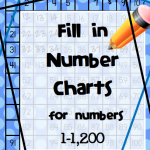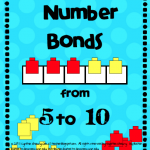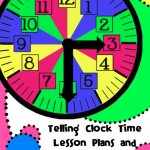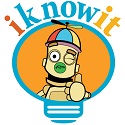What Hour is the Hour Hand REALLY showing?
When students learn about time on an analog clock, I can predict what they will confuse every year–I can predict it better than the Farmer’s Almanac predicts a cold winter.
Problem Number 1. They will mix up the hour and minute hand.
Problem Number 1 Solution: Once a child told me how he thought about the hands on a clock . What he told me is better than anything I have told kids. He said that the long hand is long because it is trying to reach the marks on the edge of the clock–therefore it tells the minutes. The short hand is shorter because it is only trying to reach the numbers and they are much closer. Now that I learned this from a 3rd grader I tell students this every year.–If what a kid said ain’t broke, don’t fix it!
What this 3rd grader said made better sense than any little ditty rhyme I have told kids, such as the “Short hand has all the power. That is why it tells the hour.” This little rhyme is great fun to say, however because short doesn’t rhyme with anything, I could just as easily confuse the long hand in this rhyme.
Problem Number 2. They will think the hour hand goes to the next hour when it gets close to the next number.
Problem Number 2 Solution: After much frustration with students thinking 7:50 was 8:50 and so on, I came up with this idea. I had them color their paper plate clocks in sections and color the number before the same color. Then I explained how all of the same color belongs to the same hour number. Below is a student clock sample of this. (I wrote over the child’s numbers with a sharpie so that you could see them in the photo.)
I further explained that as long as the tip of the hour hand is in a section, it belongs to that color and the matching colored number before that section. The numbers have property and their property is behind the number with the matching color. In the example above, the hour hand is closer to the 8 but belongs to the 7 because its tip is still in the yellow and the number 7 is also yellow–so the time is 7:55 and not 8:55.
Side note: I prefer that kids color their clocks with more than two colors because I think it causes less confusion to the eyes. I believe 3 -4 colors are best. (This teacher chose to just use 2 crayons with her class.)
More lessons on how to effectively teach time with as few misconceptions as possible (including instructions on how to make this clock above) are included here in Telling Clock Time Lesson Plans and Activities on TPT.
Come back soon for more about teaching time!
Teaching Coordinate Grids? Try These Great Resources!
A fabulous fifth grade teacher I work with started using these coordinate grid mystery pictures with her class from Super Teacher Worksheets. She said that her kids who struggled with everything else in math, loved these and were so engaged in finding the coordinates. There are many different mystery pictures that you have to pay for on their site, but I want to call your attention to a Santa Clause mystery picture that is absolutely free 🙂 especially since this is the week before Christmas! We all know how kids are the week before Christmas break–ahem–let’s just say they need something super engaging!
I also just finished revising a coordinate grid activity that I made a while back. Students must locate buried treasure on a coordinate grid using geometry and graphing terms. Our fifth graders are enjoying this activity right now, too! This activity packet is available on TeachersPayTeachers.
Social studies can be discussed with this activity since the grid has a map behind it. I like to discuss coordinate graphing on the same days I am teaching map skills in social studies because the two are so similar. This activity doesn’t explicitly teach social studies, but there is definitely room for some discussion about the maps and what part (or state) the treasure is probably in.
Support Kids and Enjoy Christmas Music at the Same Time!
I know I can usually be found stooping over the $5 bin of Christmas music in Wal-Mart this time of year because nothing brings the feeling of Christmas around more than Christmas music!! Because of this I want to share with you some beautiful Christmas music that a friend of mine wrote. All of the songs are ABSOLUTELY, breathtakingly, beautiful! They have the sound of the Transiberian Orchestra! The whole album is only $5.99, and it was just released today–December 1–to download on iTunes!! The special part about the album is that half of the proceeds are given to charity–St. Jude’s Children’s Research Hospital, Arkansas Children’s Hospital if you purchase the album through iTunes . That means that you are giving sick children $3 and really only paying $3 for the music itself. Below is a video about why the writer is giving half of the profits to charity. I’ve already downloaded mine!! 🙂
How In the World Do You Teach Rectangular Arrays and Division in 4th Grade?
Well, with large numbers this is something that my fellow colleagues did not feel comfortable teaching. And when that happens…who steps in?? None other than The Mathemagician…ta-da! (which is me of course, but shhh don’t tell anyone!!)…I’ve been off for a few days as I write this, which makes me a little sillier than normal–and probably slightly more interesting! So, on with my lesson! Now just remember when I post these pictures it is not a beautiful, I spent weeks preparing, colorful, lesson. This is a practical lesson anyone could use whether you are savvy with a computer or not. (I may turn this lesson into something more aesthetically pleasing later on.) The part that stumped the teachers was the fact that the standard says “up to 4-digit dividends”.
CCSS.Math.Content.4.NBT.B.6 Find whole-number quotients and remainders with up to four-digit dividends and one-digit divisors, using strategies based on place value, the properties of operations, and/or the relationship between multiplication and division. Illustrate and explain the calculation by using equations, rectangular arrays, and/or area models.
I had to think myself about how to teach this before I spouted off a lesson idea. (I know I am supposed to be the math expert in my building, but, honestly, I have to look up what exactly common core is expecting before I assume I know what a standard is asking students to do.) I looked at North Carolina Unpacked–my go to document for what common core expects…


The Teacher in Me Had to Share This!
So , I was out walking my dog and I just happened to notice this clump of straw on the ground in my yard. My curiosity made me stoop down and pick it up. To my surprise, I found a bird nest!!!! I’ve seen bird nests before, but somehow I’m always amazed at the work that a little bird did making such a sturdy structure. The nest was soft like a bed on the inside but the nest walls had mud packed in to the sides to help strengthen it. More coarse grassy materials were on the outside. Birds–little engineers! Yep…nothing mathematical to share at all here except there were 0 eggs in the nest. Needless to say I brought this to school to share with a teacher who could use it in her science lesson. Just the secrecy of what was in the cardboard box I carried around on the way to delivery caused plenty of kid curiosity.
Try This to Promote Fact Fluency at Your School!
Reflex Math…I LOVE IT! Kids LOVE it! In case you aren’t familiar with Reflex, it is a computer program that web based and helps students learn their math facts. The computer program is like a video game so it is very engaging to kids. I wrote more about Reflex math here. I am always trying to think of ways to encourage students to be a little more competitive about learning their facts, so I host a contest every quarter. We just finished our first Reflex contest a few weeks ago. While the contest was going on, I created a bulletin board with the students who were in 1st, 2nd, and 3rd place weekly. I also announced these students every week. When the contest was over, I posted the students photographs on the bulletin board with their names.
I also posted the students’ fluency certificates on the wall beside the bulletin board.
When students earn a certificate, they get to pick out a prize. A teacher at my school met one of the representatives from Reflex at a conference this summer and the representative gave her lots of free prizes. The kids especially love the fake tattoos.
In case you don’t have Reflex at your school and you would like to try it out, they offer grants to teachers to try it out for free for 12 months.
Counting by 1’s and Counting by 10’s Freebie!
This week, I was helping our kindergarten teachers gather some resources to teach counting by 1’s and counting by 10’s. I made these simple blank number charts that the kids could use with unifix cubes when counting. Because the vertical lines on the number chart for counting by 10’s are missing, this prompts students to group their blocks into a stick of ten for counting groups of ten. The squares are ¾ of an inch so they fit exactly with a snap cube or unifix cube. The counting by 10’s mat is made to fix ten unifix cubes exactly as well.
I am sharing these sheets for counting by 1’s and counting by 10’s with you (freebies)
Click here for the Counting By 1’s and Counting By 10’s Mat












































